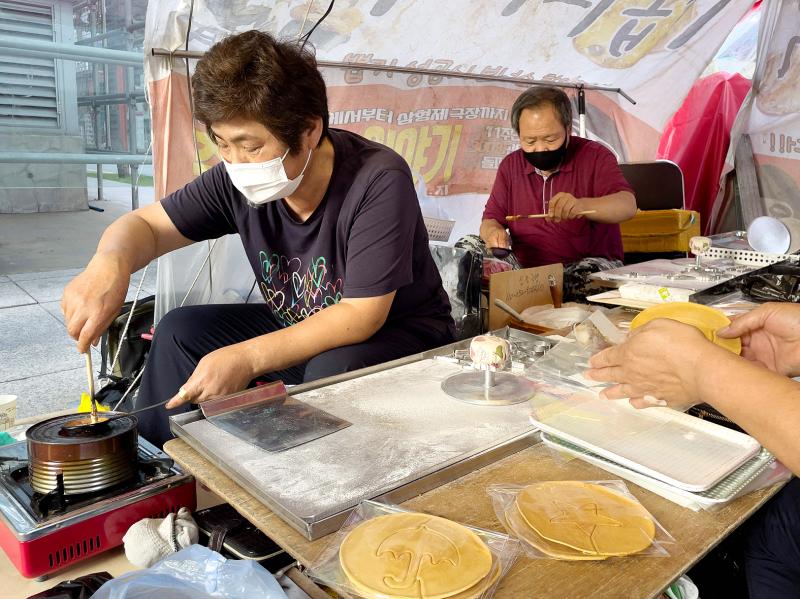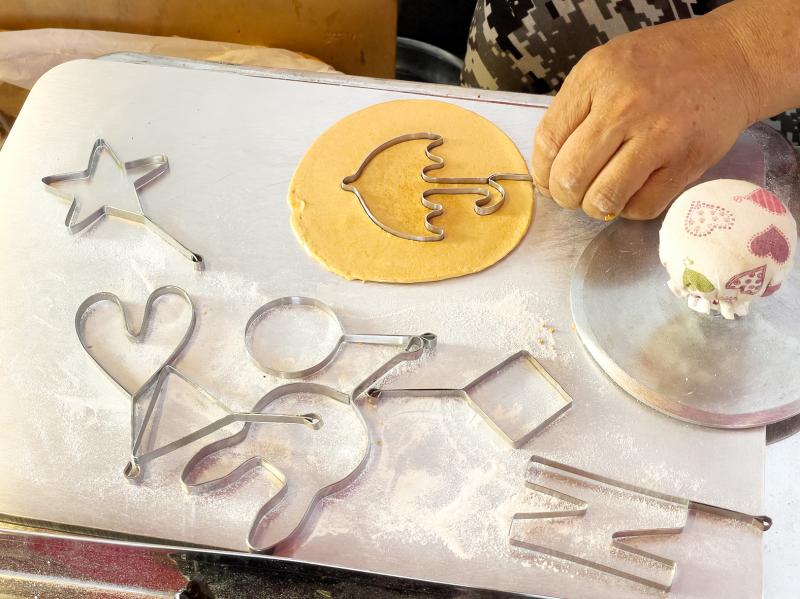Simple, sweet, and fictionally fatal: the stallholder who makes the traditional South Korean children’s treat featured in the global cultural phenomenon Squid Game — and once associated with post-war poverty — has hit a real-life jackpot.
The Netflix smash hit series features a group of South Korea’s most marginalised and deeply in debt, who compete in children’s games for the chance of 45.6 billion won (US$38 million), with lethal consequences.
In one particular challenge, the contestants try to cut out shapes including a star and an umbrella from a crisp sugar candy called a dalgona, without it cracking — and those who fail are killed.

Photo: AFP
The life-or-death game was inspired by director Hwang Dong-hyuk’s experience growing up in Seoul in the 1970s: but then, the prize for a child who successfully removed the shape was another free dalgona.
Hwang was always determined to win an extra treat and remembers employing multiple tactics in his efforts, including licking the candy to loosen the shape and using a needle heated over briquettes — techniques repeated in the show’s nail-biting dalgona challenge scene.
“I would make the dalgona maker extremely perplexed by succeeding on the most difficult shape of umbrella,” the director recently said in a YouTube video. But the candy was a difficult prop to manage on set as it softens easily, especially during South Korea’s humid rainy season, so Hwang and artistic director Chae Kyung-sun hired “dalgona experts” to have the candy freshly made on location.

Photo: AFP
Those specialists were Lim Chang-joo and his wife Jung Jung-soon, who produced between 300 and 400 dalgonas over three days of filming.
Now, their humble roadside stall in Seoul’s theatre district — little more than an umbrella, an awning and their equipment — is one of the hottest spots in the South Korean capital.
Orders for the 2,000-won (about US$1.70) sweets start piling up as soon as it opens, and before long, customers face six-hour waits, with some giving up and leaving empty-handed.
In about 90 seconds, Lim melts an individual portion of sugar above a burner, before adding baking soda, flattening it into a circle, and punching it with the customer’s preferred shape.
He offers a wider range of choices than the four forms in the show — and has a newly added “N” for Netflix.
“I never imagined it would become this popular,” Lim said of the series, adding that his life has now become “super hectic.”
“Of course, I’m happy because my business is doing well and how dalgona has become famous in other countries. I hope they make and eat their own dalgonas,” he added.
Historians say dalgona first emerged in the 1960s when the South was still assailed by post-war poverty while desserts — such as ice cream or chocolates — were not widely available and prohibitively expensive.
Very sweet, with hints of nuts and bitterness, the candy was hugely popular, with many vendors setting up their stalls near schools.
Lim and Jung started their dalgona operation with 30,000 won after closing their tailoring business of 20 years around the time of the 1997 Asian financial crisis.
The sweet endured throughout the South’s rise to become the world’s 12th-largest economy, following decades of rapid economic growth during the authoritarian rule of the post-war period.
And Squid Game is the latest manifestation of the ever-widening influence of the country’s popular culture, epitomized by K-pop sensation BTS and the Oscar-winning movie Parasite.
“South Korea has always been at the nexus of the modern and pre-modern, Western tools and Eastern ways, and preserving the past while sacrificing everything for the future,” said Michael Hurt, who teaches cultural theory at the Korea National University of Arts. “Dalgona is a nexus item in a nexus culture.”

Oct. 27 to Nov. 2 Over a breakfast of soymilk and fried dough costing less than NT$400, seven officials and engineers agreed on a NT$400 million plan — unaware that it would mark the beginning of Taiwan’s semiconductor empire. It was a cold February morning in 1974. Gathered at the unassuming shop were Economics minister Sun Yun-hsuan (孫運璿), director-general of Transportation and Communications Kao Yu-shu (高玉樹), Industrial Technology Research Institute (ITRI) president Wang Chao-chen (王兆振), Telecommunications Laboratories director Kang Pao-huang (康寶煌), Executive Yuan secretary-general Fei Hua (費驊), director-general of Telecommunications Fang Hsien-chi (方賢齊) and Radio Corporation of America (RCA) Laboratories director Pan
The consensus on the Chinese Nationalist Party (KMT) chair race is that Cheng Li-wun (鄭麗文) ran a populist, ideological back-to-basics campaign and soundly defeated former Taipei mayor Hau Lung-bin (郝龍斌), the candidate backed by the big institutional players. Cheng tapped into a wave of popular enthusiasm within the KMT, while the institutional players’ get-out-the-vote abilities fell flat, suggesting their power has weakened significantly. Yet, a closer look at the race paints a more complicated picture, raising questions about some analysts’ conclusions, including my own. TURNOUT Here is a surprising statistic: Turnout was 130,678, or 39.46 percent of the 331,145 eligible party

President William Lai (賴清德) has championed Taiwan as an “AI Island” — an artificial intelligence (AI) hub powering the global tech economy. But without major shifts in talent, funding and strategic direction, this vision risks becoming a static fortress: indispensable, yet immobile and vulnerable. It’s time to reframe Taiwan’s ambition. Time to move from a resource-rich AI island to an AI Armada. Why change metaphors? Because choosing the right metaphor shapes both understanding and strategy. The “AI Island” frames our national ambition as a static fortress that, while valuable, is still vulnerable and reactive. Shifting our metaphor to an “AI Armada”

The classic warmth of a good old-fashioned izakaya beckons you in, all cozy nooks and dark wood finishes, as tables order a third round and waiters sling tapas-sized bites and assorted — sometimes unidentifiable — skewered meats. But there’s a romantic hush about this Ximending (西門町) hotspot, with cocktails savored, plating elegant and never rushed and daters and diners lit by candlelight and chandelier. Each chair is mismatched and the assorted tables appear to be the fanciest picks from a nearby flea market. A naked sewing mannequin stands in a dimly lit corner, adorned with antique mirrors and draped foliage